Exploring the Kite Vest: Gear for Kiteboarding Enthusiasts
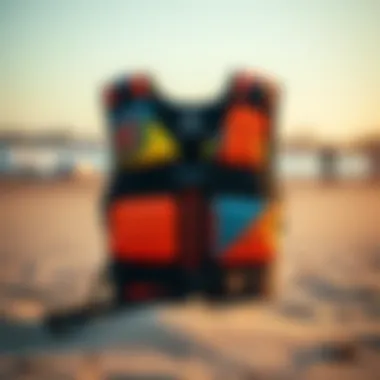
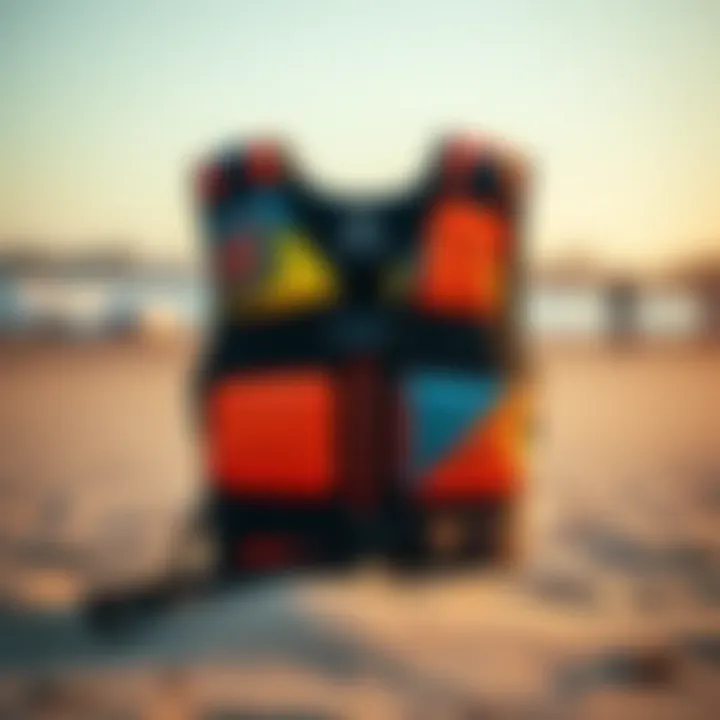
Intro
Kiteboarding has carved out its niche in the sports world, blending adventure with the thrill of harnessing wind power. One piece of equipment that often gets overlooked in conversations about kiteboarding gear is the kite vest. While many might focus on kites and boards, the kite vest serves as a critical layer of protection and functionality. This introduction aims to establish why kite vests are not merely optional; they're essential for anyone looking to navigate the waves with confidence.
For kiteboarding enthusiasts, understanding the intricacies of a kite vest can significantly enhance their overall experience. Designed to provide buoyancy and protection during high-flying tricks and unpredictable landings, a well-chosen kite vest can mean the difference between a safe landing and an unfortunate spill into the water. Furthermore, as technology advances, the features and designs of kite vests continue to evolve, integrating innovations that cater to both comfort and safety.
In this article, we'll take a closer look at the mechanics of kite vests, emphasizing their inherent role in improving both safety and performance. From material choices to innovative designs, we’ll examine how these vests hold up against the rigors of kiteboarding. We’ll also tackle some common inquiries about selecting the ideal vest, caring for it, and seizing the best options available in the market today. So, fasten your seatbelt—let's dive deep into the essential world of kite vests.
Prologue to Kite Vests
In the dynamic world of kiteboarding, selecting the right gear can mean the difference between an exhilarating ride and a potential mishap. Among the essential items on a kiteboarder's checklist is the kite vest, an accessory that has grown significantly in reputation and functionality over the years. This section casts a spotlight on the critical role that kite vests play, emphasizing not just their protective aspects but also their contribution to an enjoyable kiteboarding experience.
Overview of Kiteboarding Equipment
Kiteboarding, as a sport, demands a blend of skill and specialized gear to navigate the elements effectively. At its core, kiteboarding equipment consists of several interdependent components: the kite itself, the board, harness, and of course, the kite vest.
The kite's design evolves constantly, offering better lift and stability, while the board varies in size and outline to cater to different styles, from freestyle to wave riding. The harness, designed to connect the rider to the kite, serves for a range of functionalities. Yet, as riders zip through the waters and glide over the waves, it's often the kite vest that silently fortifies their safety and comfort, ensuring one can push the limits without losing sight of protection.
Having well-thought-out equipment is essential for any kiteboarding enthusiast, as it can significantly influence performance and safety during rides.
The Role of Protective Gear
The role of protective gear in kiteboarding extends beyond mere safety; it directly impacts performance. The kite vest, in particular, is engineered to absorb impact, shield the torso during falls, and assist in flotation should an unfortunate accident occur.
While a vest might seem like just another layer, it's a thoughtfully crafted piece of equipment. It typically includes materials designed to insulate against cold waters, prevent bruising from equipment, and safeguard vital organs from unexpected crashes.
In extreme conditions, when waves thrash and winds howl, confidence in protective gear like kite vests can encourage riders to experiment with higher jumps and more daring maneuvers. The assurance it provides allows kiteboarders to push their boundaries while simultaneously keeping safety in focus.
"Protection is key. You can’t focus on the thrill if you’re worried about your safety. A kite vest enables you to enjoy the ride with peace of mind."
As kiteboarding gains popularity, understanding the intricate details behind the kite vest and its contributions to the sport is paramount for any serious enthusiast. It’s not simply about style, but ensuring optimal performance while prioritizing safety.
Understanding the Kite Vest
Kite vests are more than mere accessories; they are critical components of the kiteboarding experience. As the sport has evolved, so has the equipment. The kite vest emerges as a staple for any serious kiteboarder, merging protection with functionality. Understanding what makes these vests tick is essential for anyone looking to elevate their kiteboarding adventures.
Design and Structure
The design of a kite vest holds sway over both performance and functionality. Not only do these vests need to be lightweight, but they should also favor mobility. Typically, kite vests are constructed to sit snugly against the body without hindering a kiteboarder's range of motion. A good kite vest features a streamlined silhouette that reduces drag while riding. It’s crafted with reinforced stitching and a flexible padding layout that can absorb impacts from potential tumbles.
Consider the various cuts—some vests offer a sleeveless option for a greater range in arm movement, while others incorporate protective sleeves for added safety. This balance between safety and maneuverability is pivotal, ensuring that you feel protected without feeling constrained.
Materials Used
When it comes to materials, kite vests boast an impressive array of technologically advanced fabrics designed to withstand the harsh marine environment. The exterior typically comprises durable, water-resistant nylon or polyester, ensuring resistance against abrasions and saltwater exposure. Inside, tactical foam or EVA provides cushioning while not compromising buoyancy.
However, the advancements in material science have brought about several innovations such as rip-stop technologies that increase durability without adding weight. Even within the realm of comfort, antimicrobial liner materials can be found, aiming to reduce chafing during long sessions on the water. The interplay of these materials creates a vest that is not only tough but also user-friendly.
Weight Distribution and Comfort
One often-overlooked aspect of kite vests is their weight distribution, which has significant implications for comfort during rides. A well-structured vest evenly distributes weight across the back and sides, so the attachment points and buoyancy elements don’t create imbalances that could affect your stance. Vests without proper weight distribution can lead to fatigue and an awkward posture, which can quickly ruin your day on the water.
Additionally, comfort doesn’t merely stem from fit; it also arises from thoughtful features like adjustable straps and side panels. These elements allow for a more customized feel, adapting to your body movements while offering sufficient support. Kite vests often integrate ventilation channels to promote airflow and reduce heat buildup, enhancing overall comfort through extended riding sessions.
"There’s nothing worse than fighting your gear instead of the wind and waves."
Understanding these critical elements of the kite vest not only emphasizes their importance in the sport but also sets the stage for informed decision-making when selecting the right vest suited to individual needs.
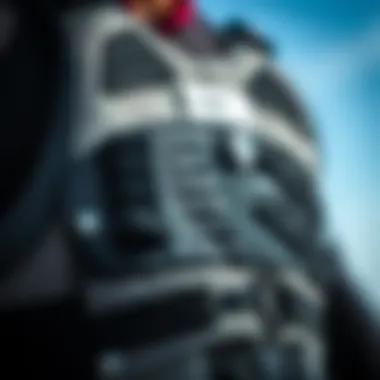
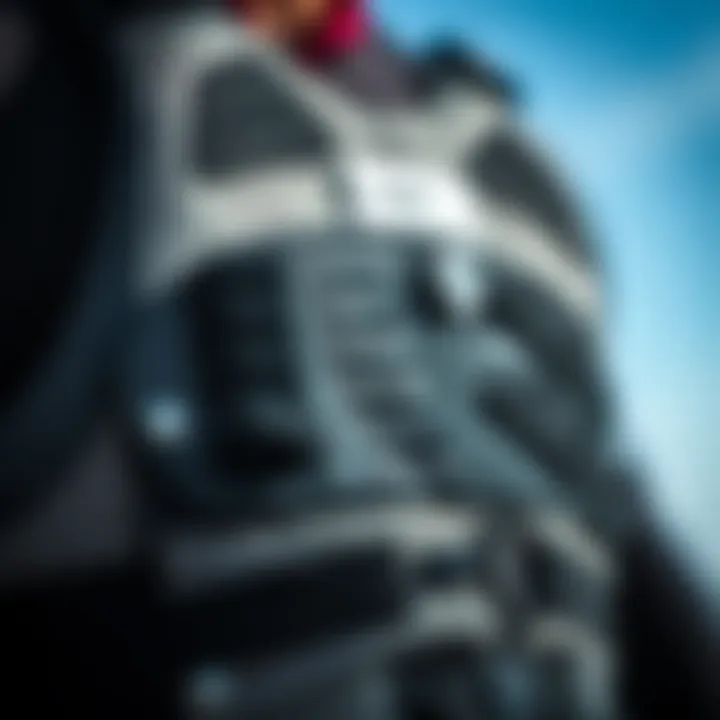
Features of Kite Vests
When it comes to the world of kiteboarding, kite vests boast a multitude of functionalities that greatly enhance not only safety, but also the overall performance of enthusiasts. These features provide an array of benefits that every kiteboarder should consider when gearing up for their next adventure on the water. It’s more than just a fashion statement; kite vests can truly make a difference when facing the elements and the unexpected.
Impact Protection
One of the key aspects of kite vests is their impact protection capability. When kiteboarding, especially for those who like to push the envelope with jumps and tricks, falls are part and parcel of the experience. Kite vests are designed to cushion the blow during those inevitable tumbles. They typically incorporate padded sections that absorb shock, minimizing injury, particularly to the ribs and back.
An example can be seen in some models that feature built-in floatation panels specifically placed to protect the torso. Without such protection, the risk of fractures or bruises increases significantly. A well-designed vest not only protects during impact but allows for more confidence while attempting new maneuvers.
Buoyancy and Floatation
Another significant benefit is buoyancy and floatation. Kite vests are made with materials that provide additional buoyancy, which can be pivotal in emergency scenarios. These vests contain various forms of flotation devices which help keep a kiter afloat should they find themselves in a precarious situation. This feature is especially beneficial for beginners or in challenging water conditions.
The buoyancy offered by these vests doesn't restrict movement. Instead, it affords a level of comfort and flexibility that enables kiteboarders to paddle back to safety or wait for assistance without compromising their ability to maneuver in the water. The right vest can truly mean the difference between a tight spot turning into a serious predicament and simply enjoying a tumble.
Pocket Functionality
Lastly, the pocket functionality of kite vests should not be overlooked. It’s quite common for kiteboarders to need access to essentials like sunscreen, keys, or even a small tool for on-the-spot repairs. Many kite vests come equipped with cleverly designed pockets that provide easy access without disrupting performance. Some pockets are even water-resistant, ensuring that your valuables stay dry while you’re riding the waves.
Consider options with zippered pockets or Velcro flaps that keep items secure and easy to reach. Keep in mind, though, that an overloaded vest can hinder movement, so it's crucial to strike a balance between functionality and weight. In the end, convenient storage solutions can elevate your kiteboarding experience by letting you keep necessary items right at your fingertips.
"A great kite vest turns potential inconveniences into seamless experiences on the water."
In summary, the features of kite vests—from impact protection to buoyancy and functional pockets—are crafted with the kiteboarder in mind, aiming to enhance safety and performance on the water. When investing in a kite vest, understanding these features can empower kiteboarders to make informed choices suited to their specific needs, ensuring more enjoyable days on the water.
Choosing the Right Kite Vest
Selecting the appropriate kite vest is a fundamental step for any kiteboarder, whether you are just dipping your toes into the sport or are a seasoned veteran maneuvering through challenging waters. While the allure of speed and adventure often takes center stage, the reality is that a kite vest’s role in safety, comfort, and performance cannot be overstated. It’s not merely a matter of looking good; it’s about ensuring that you’ve got the right gear that caters to your individual needs and preferences.
Size and Fit Guidelines
When it comes to kite vests, size truly matters. An improperly fitted vest can turn an exhilarating ride into a troublesome experience. Here are some elements to consider:
- Chest and Waist Measurements: Ensure that the vest snugly fits your body shape. A vest that is too loose can shift while you ride, while one that’s too tight may restrict movement and comfort.
- Length Consideration: It’s important to choose a length that covers your torso adequately without overextending to interfere with your arm movements. A vest that rides up can hinder your maneuverability.
- Adjustable Straps: Many vests come with adjustable buckles or straps. This feature allows for a more customized fit, accommodating different body shapes. Look for vests that offer these adjustments, especially if you plan on layering clothing underneath.
Brand Comparison
The market is saturated with different kite vest options, and selecting a reputable brand can make a significant difference in overall satisfaction and safety. A few well-regarded brands to consider include:
- Mystic: Known for their innovative designs and quality materials, Mystic vests often feature additional protective elements without compromising on comfort.
- ION: ION’s kite vests tend to incorporate lightweight materials while ensuring a snug fit. Users often commend their durability and style.
- O'Neill: This brand is celebrated for its emphasis on safety features. O'Neill vests are often designed to withstand extreme conditions, making them a great option for the more daring kiteboarder.
"Choosing the right brand is about finding a balance between comfort, safety, and style. Each brand has its unique offerings that cater to different rider preferences."
Customization Options
Customization can be a game changer in ensuring your kite vest fits your personal style and functional requirements.
- Colors and Designs: Many brands provide a choice of colors and patterns that allow you to express your personal style. Whether you prefer vibrant hues or subtle tones, there are options for everyone.
- Replaceable Panels: Some models now feature removable panels for impact protection, allowing users to tailor their protection based on their riding environment.
- Integrated Accessories: Look for vests that allow you to attach additional accessories, such as hydration packs or emergency gear. These small adjustments can enhance your experience on the water.
Kite Vest Maintenance and Care
Taking care of your kite vest is more important than one might think. Being a pivotal piece of equipment for kiteboarding, a kite vest is faced with wear and tear, not to mention exposure to saltwater, sand, and sunlight. Regular maintenance not only ensures the longevity of the vest but also contributes to the overall safety while maneuvering through the waves. Understand the specifics of how to keep your vest in tip-top shape, and you’ll improve your kiteboarding experience significantly.
Cleaning and Storage
First and foremost, cleaning your kite vest after each session is essential. Saltwater and sand can work their way into the vest's fabric, leading to a stiff and uncomfortable fit over time. Instead of throwing it in the washing machine, it’s better to rinse it gently with fresh water.
- Step-by-step cleaning:
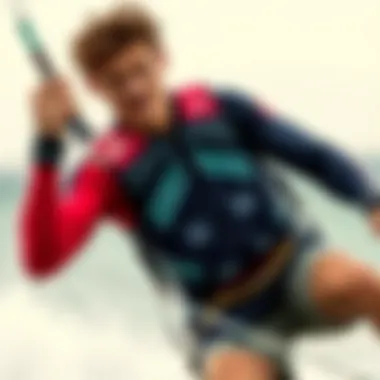
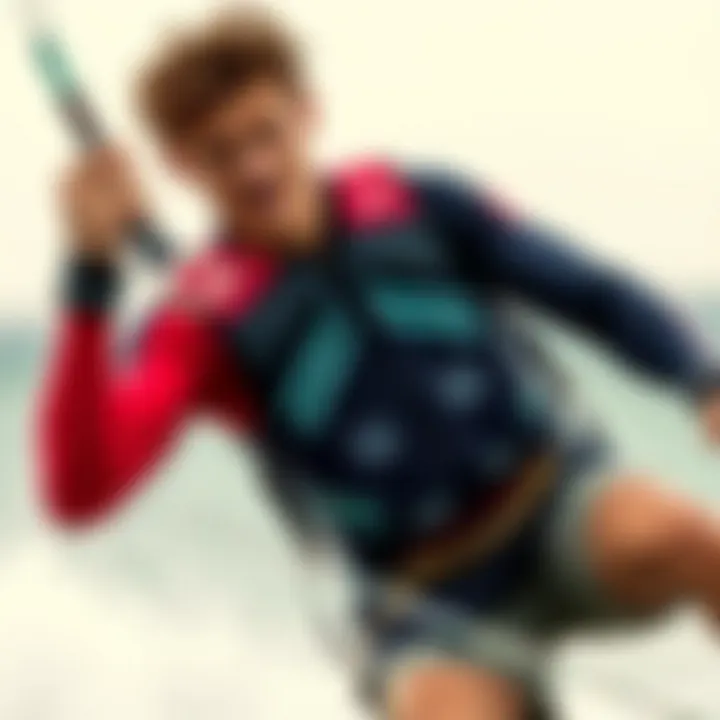
- Rinse the vest inside and out with fresh water, preferably using a hose.
- Use a mild soap if it’s particularly grimy, but avoid harsh chemicals that could damage the materials.
- After rinsing, hang the vest to dry in a shaded area to prevent any fading from direct sunlight.
- Make sure it is completely dry before storing away to avoid mildew growth.
As for storage, avoid folding it too tightly. Instead, roll it up loosely and place it in a cool, dry spot. A storage bag specifically designed for wetsuits can also be beneficial.
Inspecting for Damage
Regular inspection for any damage is a smart practice that can save you from problematic situations on the water. Consider giving your vest a thorough once-over before each session. A quick check could potentially prevent a safety issue later on.
What to look for:
- Stitching: Watch for frayed seams or loose stitches that may threaten the vest's integrity.
- Fabric Integrity: Check for signs of wear, such as stress marks or thinning material, which could compromise impact protection.
- Zippers and Fastenings: Ensure that all zippers close smoothly and securely.
- Buoyancy: If your vest feels less buoyant than before, there might be an issue with the flotation material inside.
If you spot any damage, it’s better to err on the side of caution. Seek professional repair services rather than risking it when out on the water. Maintaining your kite vest not only keeps you safe but enhances your performance in kiteboarding.
Remember, a well-cared-for kite vest is key to enjoying the thrills of kiteboarding without compromise.
Innovations in Kite Vest Technology
Kiteboarding has evolved greatly since its inception, and at the heart of this transformation lie the innovations in kite vest technology. Understanding these advancements is crucial for anyone involved in the sport, as they vastly improve safety, comfort, and performance. The importance of these technologies cannot be overstated, especially in situations where every second counts.
Smart Features
Modern kite vests are starting to integrate a variety of smart features that weren't even imagined a few years ago. For example, some vests now come equipped with built-in flotation devices that automatically deploy when a rider falls in. This means you can expect better buoyancy when you need it most, ensuring you're not just bobbing up and down in the water while waiting for rescue.
Additional smart features include GPS trackers and safety alerts. These features allow for real-time monitoring of location and conditions, adding another safety layer, especially in conditions that can go south quickly. Riders can even communicate distress signals to their partners, a critical element when kiteboarding in remote locations.
Some available smart vests can even connect to mobile applications which help the kiteboarder track their sessions, monitor heart rates, and analyze performance. This gets us thinking: how much could these innovations affect the overall kiteboarding experience? Certainly, they provide a competitive edge and peace of mind during routines.
Eco-Friendly Materials
In this modern age, sustainability seems to be on everyone’s mind, and kiteboarding gear is no exception. Recent advances have shifted focus toward eco-friendly materials in the production of kite vests. Manufacturers are now embracing biodegradable and recycled materials without skimping on quality or performance.
For example, several companies have opted for recycled nylon and organic cotton in their constructions. This not only reduces waste but also minimizes the environmental impact of their products. Choosing a kite vest crafted with eco-friendly materials can give you peace of mind, knowing that you’re making a responsible choice for the planet as well as for your kiteboarding adventures.
The consideration of eco-friendly manufacturing methods extends further to the production process, with some brands adopting energy-efficient machinery and fair labor practices. This comprehensive approach not only meets consumer demand for sustainability but also helps elevate the industry standards.
"Innovations in kite vest technology are transforming the experience; from smart functionalities to eco-friendly materials, every step forward marks both a personal and environmental victory for the kiteboarding community."
The Impact of Kite Vests on Performance
Kite vests have become more than just additional gear; they play a pivotal role in how well kiteboarders perform. While some might see these vests simply as a safety accessory, they hold deeper significance in terms of how they influence a rider's performance on the water. The well-designed kite vest contributes to various aspects of kiteboarding, including maneuverability and safety under adverse conditions. Understanding these elements can help riders make an informed choice in gear that complements their style and skill level.
Influence on Maneuverability
The design of kite vests is specifically crafted to enhance maneuverability, allowing kiteboarders the flexibility needed to execute complex movements. When the vest fits snugly yet comfortably, it reduces excess material that might otherwise get caught in the wind, detracting from a rider's agility.
Some key considerations about maneuverability in kite vests include:
- Fit Matters: A vest that is too loose may flap around in the wind, creating drag and complicating turns. Conversely, one that fits too tightly can restrict movement.
- Low-Profile Design: Modern kite vests often feature a sleek design that minimizes bulk. This means less restriction and more freedom to shift your weight as necessary, which is crucial for making sharp turns or jumping high.
- Stability in Motion: When you're carving up the waves, a well-structured vest ensures that it stays in place, allowing you to focus more on your kiting technique rather than adjusting your gear.
Overall, investing in a kite vest specifically tailored for a kiteboarder's style could mean the difference between a lackluster ride and a thrilling performance.
Safety During Extreme Conditions
No one likes to think about the worst-case scenarios when kiteboarding, but it’s essential to prepare for the unexpected. Kite vests serve a dual purpose: they enhance performance and act as a safety net when conditions turn dicey. In extreme situations, the right vest can provide critical protection.
- Impact Resistance: Many kite vests incorporate padding designed to absorb shock from falls or collisions. This feature protects the torso, particularly essential when hitting the water at high speeds or navigating crowded areas.
- Floatation Aid: A vest's buoyancy capability becomes invaluable in rough waters or when a rider finds themselves separated from their board. While kite vests aren't substitutes for life jackets, they can provide extra floatation, making it easier to stay afloat until help arrives.
- Peace of Mind: Just knowing that you have that extra layer of protection can bolster a rider’s confidence. Feeling secure can encourage bold maneuvers and improve overall performance, as the fear of injury diminishes.
In summary, the role of kite vests in performance is multi-faceted. They contribute to agility on the water and provide a safety cushion during intense sessions. When choosing a kite vest, being aware of these factors can have a significant impact on your kiteboarding adventures.
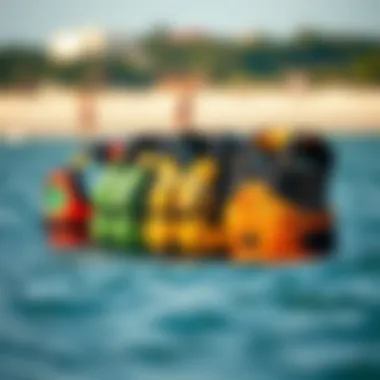
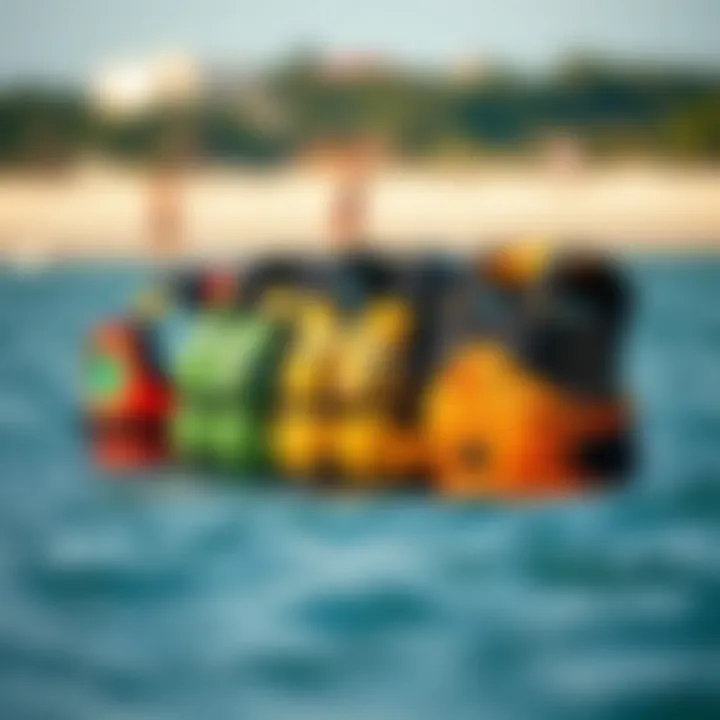
Common Questions About Kite Vests
In the evolving landscape of kiteboarding, kite vests have piqued the interest of many. So, it’s crucial to address some common questions that arise when considering this piece of equipment. Understanding the subtleties of kite vests helps riders of all levels appreciate their value. Riders often ask themselves: Are kite vests truly necessary? What should I consider when selecting one? These questions are not just about gear but significantly impact safety, comfort, and performance on the water.
Are Kite Vests Necessary for All Levels?
Many newcomers ponder whether kite vests are exclusively for seasoned kiteboarders or if they are beneficial for beginners too. The answer, in short, is that kite vests play an essential role universally across skill levels. For newbies, these vests can be a safety lifesaver, offering buoyancy which helps alleviate the fear of falling into the water. With the added impact protection they provide, kite vests enable learners to gain confidence while mastering their skills.
As kiteboarding progresses, the riders face increased speeds and potentially challenging conditions. Whether you’re just getting your feet wet or carving large arcs in the air, a kite vest becomes an ally. It not only protects against the slap of water during hard landings but also assists in preventing injury from gear or environmental factors, like sharp objects in the water. More experienced riders might find vests that offer enhanced features suited for advanced maneuvers.
"A kite vest is more than just a piece of equipment; it’s part of the kiteboarding experience that enhances safety and performance for all levels."
Can You Use a Life Jacket Instead?
The idea of using a standard life jacket instead of a kite vest often creeps into discussions, but it’s essential to understand the differences between the two. Life jackets, designed primarily for flotation, can be somewhat cumbersome and hinder the movements that kiteboarding demands. While they offer buoyancy, they often lack the streamlined design and comfort that a kite vest provides.
Kite vests are tailored specifically for kiteboarding, incorporating lightweight materials and thoughtful designs aimed at enhancing body movement. They allow freedom to twist, turn, and perform tricks without the bulkiness that can come with a typical life jacket. Suitable kite vests often integrate floatation materials and protective padding, striking a balance between buoyancy and flexibility, perfect for dynamic activities like kiteboarding.
Community Perspectives on Kite Vests
Understanding how kiteboarders feel about kite vests is essential for grasping their importance within the sport. This section dives into firsthand experiences, opinions, and studies focusing on kite vests, offering a well-rounded view that goes beyond mere specifications and features. Knowing what fellow riders value or struggle with can provide insights into performance, design adaptability, and how these vests are perceived in varied conditions.
Surveys from Kiteboarders
Surveys are a fascinating tool for gauging community sentiment. They bring together a multitude of voices from varying backgrounds, providing a comprehensive snapshot of what kiteboarders think regarding kite vests. Recent surveys have surfaced some interesting stats:
- Comfort Level: Around 75% of the participants emphasize that comfort is a paramount factor. Many mentioned that ill-fitting vests can indeed impair the joy of kiteboarding.
- Safety Perception: Nearly 90% agreed that kite vests enhance safety. Riders reported feeling more secure while engaging in jumps and tricks with the additional protection they offer.
- Feature Preferences: A significant majority (85%) expressed interest in vests with ample pocket space. Kiteboarders want easy access to essentials like keys and GoPros without fumbling mid-ride.
From the feedback of kiteboarding communities, it's clear that functionality and fit are crucial, but so too is the psychological comfort that a properly designed vest provides. It’s not just that kite vests offer physical padding; they can serve as a confidence booster against falls and sudden crashes. Perhaps this balance between functionality and peace of mind is the key takeaway from these surveys.
Expert Insights
When it comes to kite vests, expert opinions can be illuminating. Many industry veterans and seasoned kiteboarding coaches frequently highlight the critical balance of safety and performance that kite vests must achieve. An anonymous instructor with over a decade of experience shared, “A quality vest needs to feel like a second skin, not a cumbersome sack.”
Experts also touch on the importance of evolving designs:
- Adaptability: Kiteboarding conditions can change in a heartbeat. Professionals argue that vests should allow for movement—not just the movement of surfing, but also to adjust to unexpected winds. In environments where rapid maneuvering is essential, a kite vest must facilitate that.
- Advancements in Material: Many professionals emphasize the shift to lightweight, breathable materials. One notable commentary struck the right chord: “If it feels like you forgot to take it off after a session, then it’s doing its job well.”
Interestingly, some experts note the rise of eco-friendly materials in kite vests as a significant trend. They believe that as sustainability becomes increasingly important, brands that prioritize this will likely attract a loyal following among environmentally-conscious kiteboarders.
Quality kite vests are not only about protection; they represent a commitment to enhancing the kiteboarding experience.
In summary, community insights and expert reflections converge to reinforce the significant role kite vests play in the kiteboarding experience. They aren't simply an accessory but rather an integral part of the sport, serving both practical and emotional needs for riders. For those looking to invest in one, tuning into these perspectives may guide more thoughtful purchasing decisions.
Finale
The role of kite vests in the world of kiteboarding cannot be overstated. They serve as an essential layer of protection and comfort, making a significant difference in a rider's experience on water. With the windy gusts and waves crashing about, having a reliable vest can help you feel secure while tackling challenges out there.
The Essential Role of Kite Vests in Kiteboarding
Kite vests offer various advantages that go beyond just being a piece of safety gear. First and foremost, they provide impact protection. When powered up by the wind, the last thing you want is to endure an injury from a fall or collision. The padding integrated into these vests absorbs shocks, lessening the impact and enhancing safety for riders of all levels.
Another vital feature is buoyancy. This is not just about floating on water but rather maintaining stability and balance while maneuvering. Kite vests often come with floatation devices that help keep you afloat, which is crucial during unexpected spills. This buoyancy also allows for a more confident approach to risky tricks, as you know recovery will be easier.
Surprisingly, kite vests enable better performance. With their design focused on aerodynamics, these vests allow for freedom of movement. Unlike bulky life jackets that can weigh you down, a well-fitted kite vest adheres closely to your body, giving you the flexibility needed to make those sharp turns or rapid accelerations without hindrance.
Future of Kite Vests in Kiteboarding Gear
Looking ahead, the future of kite vests seems poised for innovation. Ongoing developments in the material science field are paving the way for lighter yet more effective fabrics that can offer enhanced durability and safety. Imagine a vest that not only provides buoyancy but also self-inflates in emergencies or communicates with a smart device to alert others of a rider’s distress.
Sustainability is another area gaining traction. As environmental consciousness grows, we can expect marine-grade recycled materials to become common in the construction of kite vests, significantly lowering their ecological footprint.
With technology evolving, we might soon see kite vests equipped with GPS trackers, allowing for improved tracking and safety measures on the water. This adjustment would greatly appeal to enthusiasts who venture into new waters or explore remote locations.
In summary, kite vests deliver a mix of protection, performance enhancement, and comfort essential for kiteboarding. Their evolution over the years proves they are not just an accessory but a necessary component of this thrilling sport. As kiteboarding continues to grow, the kite vest will undoubtedly adapt, further solidifying its importance in the gear lineup.







